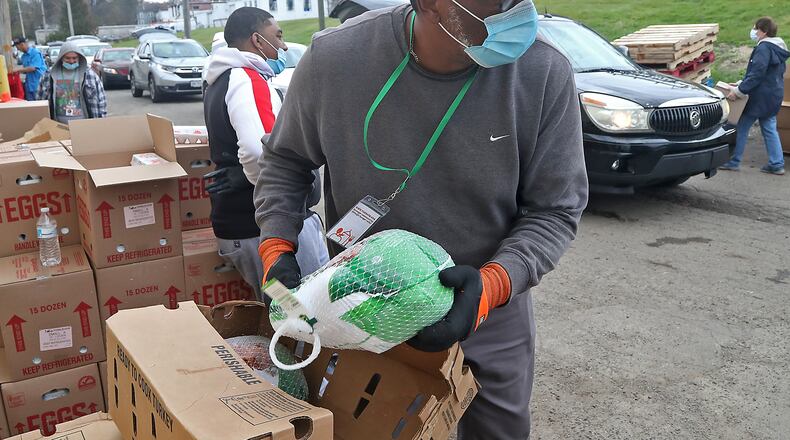“We need our community once again more than ever because of the increase in prices,” said Tyra Jackson, the executive director of Second Harvest.
The food bank has seen about 50 volunteers throughout this year compared to the more than 2,000 people typically seen helping during non-pandemic years.
Second Harvest has a staff of 18 full-timers, and 15 temporary employees helping out for the holiday season.
Volunteers usually operate in small groups throughout the year. However, the shortage during the pandemic stems from health concerns, and companies that usually volunteer their employees are also dealing with the economic impacts of the pandemic.
Though her organization is expected to see less people request services compared to the huge jump in need seen last year, Jackson said that they are still serving a lot more people this year than in 2019.
Food insecurity has been a steady problem in the region for some time, however, it was made worse due the precarious economic situation for many during the pandemic.
Prior to the pandemic, more than 35.2 million people across the country, including 10.7 million children, were considered food insecure, according to the nonprofit Feeding America. This year, the organization projects that number will rise to a total of more than 42 million people, including 13 million children.
In 2019, the rate of food insecurity was 14.5% in Clark County, 12.3% in Champaign County and 12.2% in Logan County.
Throughout 2021, these numbers have been projected to increase to a rate of 15.4% in Clark and 13% in both Champaign and Logan counties, according to the nonprofit Feeding America.
Second Harvest served more than 37,000 people in 2019 before seeing that number shoot up to more than 65,000 in 2020. For this year, Second Harvest, which serves communities in Clark, Champaign and Logan counties, is expected to provide food to a little more than 50,000 people.
The holiday season of November and December usually sees more people utilizing services due to an increase in donations and awareness of services, Jackson said.
This year, Second Harvest is expecting to see somewhere between 6,000 to 7,000 households during that period, representing 18,000 to 20,000 people.
Jackson said they are expecting an increase of 10% to 15% when compared to the same period in 2019. However, it is lower than what was seen last year as the food bank served between 25,000 and 30,000 people during November and December.
However, this year brings new challenges as the pandemic has caused rising inflation this year for certain food supplies and other products.
The food bank is also making do without help from the Ohio National Guard, which provided support through March 2020 to July of this year. Federal relief money allocated last year was factored into current expenses, but projected costs for the food bank went up in 2021 by 20% to 30% than what was originally projected.
Temporary employees have been hired to fill the gap left by the National Guard.
Jackson said that is mainly due to inflation in food prices. Meat has gone up as well as can goods and other needed food supplies.
“I think a lot of people understand it because they are going to the grocery stores and they see the change in their bill as they are checking out as well,” said Jackson.
The non-profit also relays heavily on donations this time of year, usually seeing $200,000 to $300,000 being donated during November and December, Jackson said.
“These two months are critical for us and for our budget to allow us to provide the services that we provide,” she added.
Second Harvest receives funding from various sources including local organizations such as the United Way, grants and from state and federal governmental agencies.
Jackson said as they move forward, the goal is to raise more awareness and highlight services offered by the food bank as well as the need.
For those wishing to help out, they can contact Second Harvest at (937) 325-8715 and there location in Springfield is at 20 North Murray Street.


